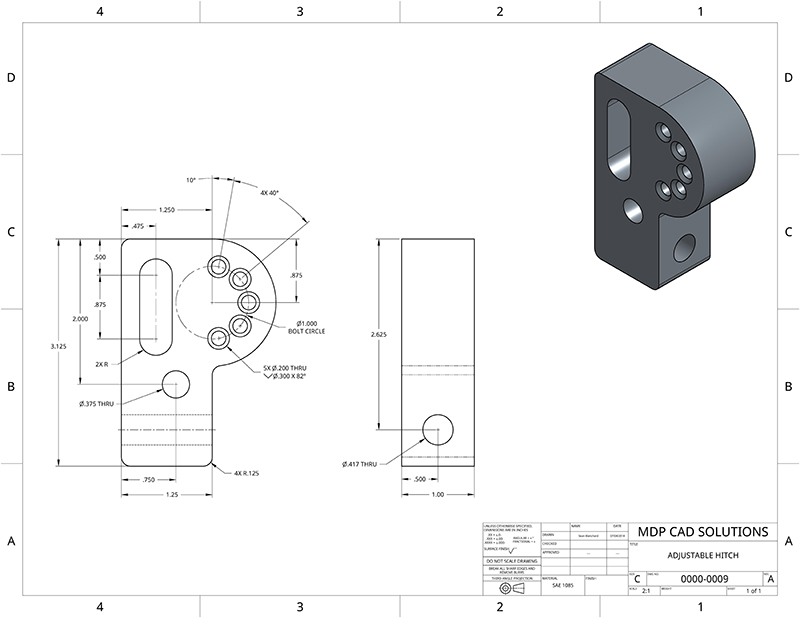Computer-aided design (or CAD) software is used by graphic artists, architects, interior designers, engineers, and many others to craft blueprints, technical drawings, and other renderings for a variety of purposes. General contractors, builders, manufacturers, and related fields use these drafts to envision a finished project as well as to facilitate the construction of the product itself.
Given that so much these days needs to be viewed in three dimensions for the most effective and efficient process, it makes sense that CAD renderings can also be furnished in full 3D.
3D CAD design allows for the manipulation, extraction, and rendering of robust technical data points into a lifelike model. Unlike flat drawings and two-dimensional blueprints, 3D rendering services build out a virtual environment that can be presented and even altered in real-time. The many important and varied benefits of such working models for a range of professions are, of course, not all that difficult to imagine.
For example, architectural designers and their clients alike can see what a project might look like when it is fully completed before the foundation is even laid. Manufacturers can create virtual prototypes of a new product and see its uses and potential issues without having to construct a physical device. Engineers can create working, three-dimensional models of municipal infrastructure that cities and planners utilize to ultimately influence major decision-making processes.
All that being said, this was not always the case. In the days before computer-aided design software, draftsman and women had to manually draw out every blueprint and working drawing no matter how tedious (and it was always tedious). This was incredibly time and labor intensive.
After this time, but still prior to the advent of computer-generated 3D modeling, computer-aided design software allowed only for basic, fundamental, two-dimensional drawing work.
While this was certainly helpful and an improvement over the hand-drawn methods, it did not replace the need for some amount of physical creation to be completed during the manufacturing process.
Given how far this process has come, it is worthwhile to take a look at where it began and how it got to where it is now. Along the way, it is useful to consider the different methods and procedures that made 3D CAD design the tool it is. This provides additional context and perspective on how artists, designers, and engineers now make their work more valuable and more efficient at the same time.
The Beginning of 3D CAD Design

The beginning of computer-aided design software and 3D CAD design stretches all the way back to the middle of the twentieth century. In fact, it is not an understatement to say that most of it goes back to a single man, an engineer named Patrick Hanratty, the father of it all.
In 1957, Patrick J. Hanratty wrote the Pronto code while working at General Electric. Around that time, Hanratty also started to work in the field of computer-generated graphics, which very few people had done up to that point.
In the early sixties, Hanratty transitioned to General Motors where he worked in the research laboratory. During his time there, he developed one of the very first computer-aided design systems, called DAC, for “design automated by computer.”
This original CAD program was able to incorporate responsive visual graphics for the user, an unprecedented development in computing, if only two-dimensional in nature.
Initially, the system was primarily used in the automotive industries, and ultimately it became outmoded and another system took its place. Because of this, Hanratty began his own enterprise in the 1970s, in order to create and sell a new CAD drafting solution.
As a result of the narrow implementation dynamics of the software and the fact that Hanratty had written the code in a programming language that very few people actually knew (it was his own, in fact), the company did not last.
At long last, Hanratty finally made a commercial success in a new company called Manufacturing and Consulting Services. His new software was called Adam, and it allowed for an integrative and responsive system for graphics representation, technical drawing, and manufacturing.
He wrote the program in a widely understood and used programming language and created it to operate on practically any computing device available at the time, which certainly helped create a favorable outcome.
Many people say that all modern computer-aided design software packages trace back to Hanratty and his Adam programming code. Without the development of his graphical design program solution, it is possible that a very different world of computer graphics would be available today.
The Evolution of 3D CAD Design

Hanratty may have started the whole field of three-dimensional graphic interfacing for designers and mechanical engineers, but the technology has come a long way since the burgeoning days of the 1970s.
With the 1980s came the advent of UNIX computer terminals and the whole landscape changed. As a result, large commercial computer-aided design software systems such as CATIA (short for “computer-aided three-dimensional interactive application”) started to appear, most notably in the automotive and aerospace fields.
However, it was not until the appearance of the initial IBM personal computer that the world would be primed for the wide acceptance of CAD programs.
Arguably, though, no year is more pivotal for CAD design software solutions than 1982. In that year, a band of computer programmers joined together and created the company known as Autodesk. A year later, they made their flagship program, AutoCAD, available to the world.
It was the very first notable computer-aided design software package made for IBM computers, and again the field was changed forever.
The release of AutoCAD was a major landmark event in the evolution of computer-aided design software. The programmers at Autodesk had the objective of making a product that did nearly everything that other CAD software packages could do at the time while charging a fraction of the cost.
In so doing, Autodesk singlehandedly changed the trajectory of CAD programming and commercial availability and affordability for decades to come. Even so, nearly all such programs remained stuck in just two dimensions.
The program that altered the landscape yet again — and literally gave the design world another dimension — was called Pro/ENGINEER made by Parametric Technology Corporation.
It was a computer-aided design solution founded on three-dimensional geometry and feature-rich, value-based operations for determining aspects and assemblies of engineering or design projects. The program is actually still in use on Microsoft PCs, though it goes by the name of Creo now.
Pro/ENGINEER (Creo) also operated on UNIX computer terminals, since personal computers did not have enough processing power and speed to reliably utilize such software, but it was still a major turning point. Eventually, two other like-minded programs, ACIS and Parasolids, were released, each of which would establish the foundation for other parametric computer-aided design software packages and graphics solutions.
3D CAD Design Today

Today, the 3D design software world is a virtual cottage industry of programs and graphics packages that do practically anything that a designer or engineer could imagine. The aforementioned Autodesk is the leader in the field of CAD programs, but there are many others as well, some of which cater to a variety of narrower more niche fields or interests.
A few major examples of current 3D CAD design solutions include the following: 3ds Max, Blender, Cinema 4D, Rhino3D, SketchUp, Fusion 360, and SolidWorks. Believe it or not, these are actually all popular solutions in this field, depending on the designer or engineer in question and their specific needs.
Some of these are even completely free to use, a pretty remarkable indication of how far this particular industry has come since its early days.
The work that these programs are able to process and render is truly remarkable and, in some cases, quite breathtaking. From architectural designs and working patent prototypes all the way to interactive 3D graphics for entertainment and media companies like HBO or PlayStation. Whether it’s an addition to a home, a new product line for manufacturing, or even a robust and interactive video game, 3D CAD design software solutions make it all possible as never before.
How Cad Crowd Can Help
Bringing Cad Crowd on board with your 3D CAD design project means that you can work with an exclusive group of the world’s greatest freelancers in nearly every design or engineering field in existence. We have a community of technical draftsmen and women, designers, and 3D drafting and design services all over the globe.
They have years of experience working across a wide range of software within a diverse spectrum of businesses. Whatever your 3D CAD design needs may be, Cad Crowd can help you get exactly where you need to go. We can meet every 3D CAD design solution as well as 2D to 3D conversion services, regardless of the project field or scope.
We have the ability to help you by utilizing a range of the most updated programs. Our network is made up of the best experts using the highest quality current computer-aided design software. Just let us know if there is a particular application you need us to use, and we will locate the perfect 3D CAD design artist, designer, or engineer for your project.
The services available at Cad Crowd are at the disposal of clients who currently have drafts or models in-hand and need additional assistance with the task of rendering or further development utilizing a broad range of expert 3D CAD design engineers and designers.
Cad Crowd is simply the best place to get everything your 3D CAD design project needs to be researched, designed, drafted, engineered, or rendered. Start working with us today. Find out how it works.
